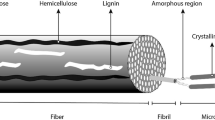Abstract
2,2,6,6-Tetramethylpiperidine-1-oxyl radical (TEMPO)-oxidized cellulose nanofibers were prepared from two kraft pulps (Norway spruce and mixed eucalyptus) using the TEMPO/NaBr/NaClO system at pH 10 and 22 °C. After reaction and mechanical treatment, the TEMPO-oxidized celluloses were used for preparation of self-standing films and coatings of laminate films on 50-μm-thick polyethylene terephthalate films. Characterization of the films was performed based on water contact angle measurements, laser profilometry, scanning electron microscopy, and field-emission scanning electron microscopy. The purpose of this study is to understand how the measured contact angles are affected by the film’s physical properties (morphology, thickness, density, and roughness).









Similar content being viewed by others
References
Bee T, Cross E, Dias A, Lee K-W, Shoichet M, McCarthy T (1992) Control of wettability of polymers using organic surface chemistry. J Adhes Sci Technol 6:719–731
Bragd P, van Bekkum H, Besemer A (2004) TEMPO-mediated oxidation of polysaccharides: survey of methods and applications. Top Catal 27:49–66
Cassie A, Baxter S (1944) Wettability of porous surfaces. Trans Faraday Soc 40:546–551
Chinga G, Johnssen P, Dougherty R, Lunden-Berli E, Walter J (2007) Quantification of the 3-D micro-structure of SC surfaces. J Microsc Oxford 27(3):254–265
Chinga-Carrasco G, Syverud K (2010) Computer-assisted quantification of the multi-scale structure of films made of nanofibrillated cellulose. J Nanopart Res 12:841–851
Chinga-Carrasco G, Yu Y, Diserud O (2011) Quantitative electron microscopy of cellulose nanofibril structures from Eucalyptus and Pinus radiate kraft pulp fibers. Microsc Microanal 11:1–9
Ek M (2009) Paper chemistry and technology, vol 3. de Gruyter, Berlin
Erbil H (2006) Surface chemistry of solid and liquid interfaces. Blackwell, Oxford
Fukuzumi H, Saito T, Iwata T, Kumamoto Y, Isogai A (2009) Transparent and high gas barrier films of cellulose nanofibers prepared by TEMPO-mediated oxidation. Biomacromolecules 10:162–165
Henriksson M, Henriksson G, Berglund L, Lindström T (2007) An environmentally friendly method for enzyme-assisted preparation of microfibrillated cellulose (MFC) nanofibers. Eur Polym J 43:3434–3441
Karabulut E, Wågberg L (2011) Design and characterization of cellulose nanofibril-based freestanding films prepared by layer-by-layer deposition technique. Soft Matter 7:3467–3474
Minelli M, Baschetti M, Doghieri F, Ankerfors M, Lindström T, Sirό I, Plackett D (2010) Investigation of mass transport properties of microfibrillated cellulose (MFC) films. J Membrane Sci 358:67–75
Mittal K (2009) Contact angle, wettability and adhesion, vol 6. Leiden, Boston
Moutinho I, Figueiredo M, Ferreira P (2007) Evaluating the surface energy of laboratory-made paper sheets by contact angle measurements. Tappi J 6:26–32
Pääkkö M, Ankerfors M, Kosonen H, Nykänen A, Ahola S, Östenberg M, Ruokolainen J, Laine J, Larsson P, Ikkala O, Lindström T (2007) Enzymatic hydrolysis combined with mechanical shearing and high-pressure homogenization for nanoscale cellulose fibrils and strong gels. Biomacromolecules 8:1934–1941
Papakonstantinou D, Amanatides E, Mataras D, Ioannidis V, Nikolopoulos P (2007) Improved surface energy analysis for plasma treated PET films. Plasma Process Polym 4:1057–1062
Rasband W (1997) ImageJ. U.S. National Institutes of Health, Bethesda. http://rsb.info.nih.gov/ij
Ryan B, Poduska K (2008) Roughness effects on contact angle measurements. Am J Phys 76:1074–1077
Saito T, Nishiyama Y, Putaux J, Vignon M, Isogai A (2006) Homogeneous suspensions of individualized microfibrils from TEMPO-catalyzed oxidation of native cellulose. Biomacromolecules 7:1687–1691
Saito T, Kimura S, Nishiyama Y, Isogai A (2007) Cellulose nanofibers prepared by TEMPO-mediated oxidation of native cellulose. Biomacromolecules 8:2485–2491
Spence K, Venditti R, Rojas O, Habibi Y, Pawlak J (2010) The effect of chemical composition on microfibrillar cellulose films from wood pulps: water interactions and physical properties for packaging applications. Cellulose 17:835–848
Syverud K, Xhanari K, Chinga-Carrasco G, Yu Y, Stenius P (2011) Films made of cellulose nanofibrils: surface modification by adsorption of a cationic surfactant and characterization by computer-assisted electron microscopy. J Nanopart Res 13:773–782
Taniguchi T (1998) New films produced from microfibrillated natural fibers. Polym Int 47:291–294
Turbak A, Snyder F, Sandberg K (1983) Microfibrillated cellulose, a new cellulose product: Properties, uses, and commercial potential. J Appl Polym Sci Appl Polym Symp 37:813
Wågberg L, Decher G, Norgren M, Lindström T, Ankerfors M, Axnäs K (2008) The build-up of polyelectrolyte multilayers of microfibrillated cellulose and cationic polyelectrolytes. Langmuir 24:784–795
Zhang C, Wang L, Zhao J, Zhu P (2011) Effect of drying methods on structure and mechanical properties of bacterial cellulose films. Adv Mater Res 239–242:2667–2670
Acknowledgments
The authors would like to thank Per Olav Johnsen for acquisition of FESEM images, Professor Torbjørn Helle for linguistic help, and project partners in the SustainBarrier project at PFI for financial support.
Author information
Authors and Affiliations
Corresponding author
Rights and permissions
About this article
Cite this article
Rodionova, G., Eriksen, Ø. & Gregersen, Ø. TEMPO-oxidized cellulose nanofiber films: effect of surface morphology on water resistance. Cellulose 19, 1115–1123 (2012). https://doi.org/10.1007/s10570-012-9721-5
Received:
Accepted:
Published:
Issue Date:
DOI: https://doi.org/10.1007/s10570-012-9721-5




